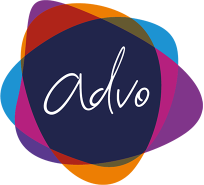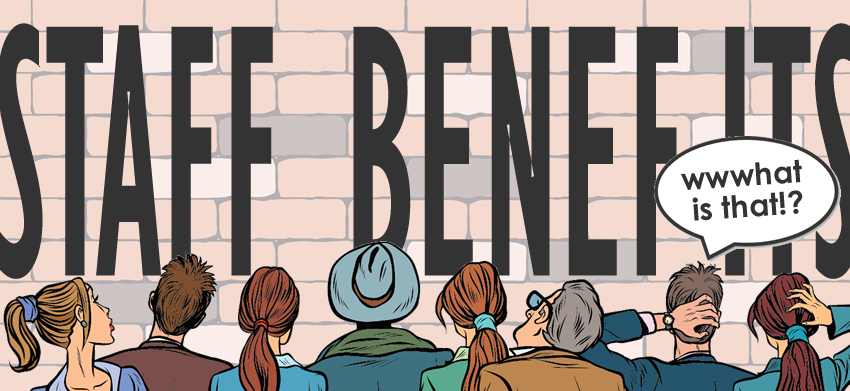Surprisingly, a recent survey by GRiD revealed that only 57% of employers believe their workforce is aware of all their benefits and understands them with an incredible 35% of employees say their company doesn’t communicate benefits or they don’t remember if they do.
In research* revealed today by GRiD, the industry body for group risk, only 57% of employers believe their workforce is aware of all their benefits and understands them.
- 28% of employers believe their workforce is aware of all their benefits but doesn’t understand them all.
- 10% of employers believe their workforce is only aware of some of their benefits.
Katharine Moxham, spokesperson for GRiD says: ‘A huge amount of resource, time, energy and money is invested in compiling employee benefits packages. This is maximised when a workforce is aware of the benefits and understands them.’
Appreciation of benefits is connected to how well they’re communicated, so the research also looked at the frequency and methods of communication.
- 38% of employers communicate details of their benefits when there’s a change to the terms and conditions of a particular benefit
- 29% communicate benefits at recruitment stage
- 26% communicate benefits at least quarterly
- 22% communicate benefits at performance reviews
- 21% communicate benefits once a year
- 8% don’t communicate their benefits at all.
The most effective communication strategies are those that are regular. Employee benefits don’t always resonate with employees if they don’t seem relevant at a particular point in time. However, life stages and circumstances change regularly, so benefits that weren’t relevant one day, may very well be the next.
Moxham continued: ‘We see people at some of the most vulnerable stages in their life in our industry: at times of ill-health, disability and bereavement. Circumstances that by their nature are often unforeseen. This is exactly why benefits that support such situations need to be communicated regularly, so they are front of mind when they are needed.’
Communication methods
By far the most popular method for communicating benefits is in a staff welcome pack (38%). Posting details to home addresses was the least popular, according to employers.
Interestingly however, employees** have a different recollection of the methods their employers use. And over a third (35%) don’t believe their employer communicates benefits or can’t remember if they do.
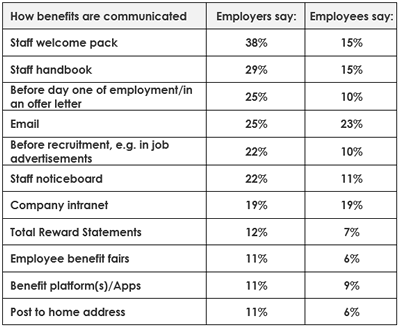
There’s a disconnect between how employers communicate, and what employees remember. This clearly demonstrates the need for regular communication and using a mix of methods for communications to be effective. Employees won’t always remember what’s been communicated if it wasn’t important at the time.
Likewise, different methods will resonate more with some employees than others. Some will diligently read their welcome pack or handbook, and others will be more likely to engage with the company intranet. There are also increasing options to promote digitally, and it’s important that this method is also embraced to reach all sections of a workforce.
Moxham concluded: ‘These findings are particularly pertinent given new legislation, which came into force 6 April this year requiring employers to inform employees about their employment and benefits on day one or on request***. But, in addition to complying with this, to increase engagement and for benefits to be utilised, they need to be understood, to which communication is central. Whether we’re talking about pensions, healthcare, employer-sponsored life assurance, income protection or critical illness, the approach needs to be the same. Employers need to tell their workforce what they’re offered, communicate via as many means as possible, and do so regularly.
Jamie Tuffield, who heads up the employee benefit advisory team at advo commenting on the survey results said “In an unprecedented time of change, how employees perceive, understand and engage with their benefits will be a crucial tool in company culture and employee wellbeing. At advo we make the complex simple, with our dedicated specialist advisors bringing benefit packages to life for employers and employees, underpinned by award winning user friendly tech”
Benefit Q&As from the GRiD survey
Do you believe your employees are aware of the employee benefits you offer, and understand them? This is not just related to the ones mentioned in this survey, but all benefits, including pension, healthcare, etc.

How often do you communicate your employee benefits to staff?
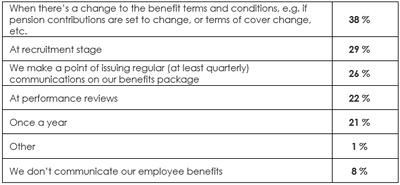
How does your company communicate the employee benefits offered? This can be anything from company pension, access to private healthcare, employee assistance programmes, cash plans to group risk protection benefits. (all that apply selected)
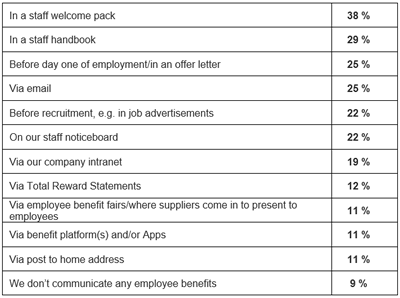
Q to employees:
How does your company communicate the employee benefits they offer you? This can be anything from company pension, access to private healthcare, employee assistance programmes, cash plans to group risk protection benefits. (all that apply selected). Base size of employees 1,165
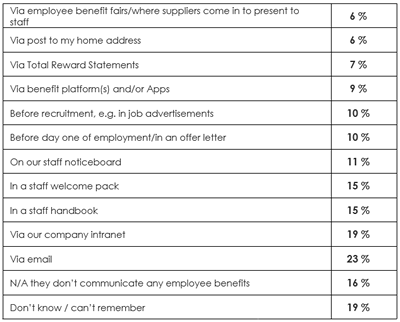
* Research undertaken by Opinium on behalf of GRiD amongst 500 HR Decision makers between 27-31 January 2020
** Research undertaken by Opinium on behalf of GRiD amongst 1,165 employees between 24 and 28 January 2020.
*** The Employment Rights (Employment Particulars and Paid Annual Leave) (Amendment) Regulations 2018 (SI 2018/1378)
You can read the GRiD Press release in full here.
